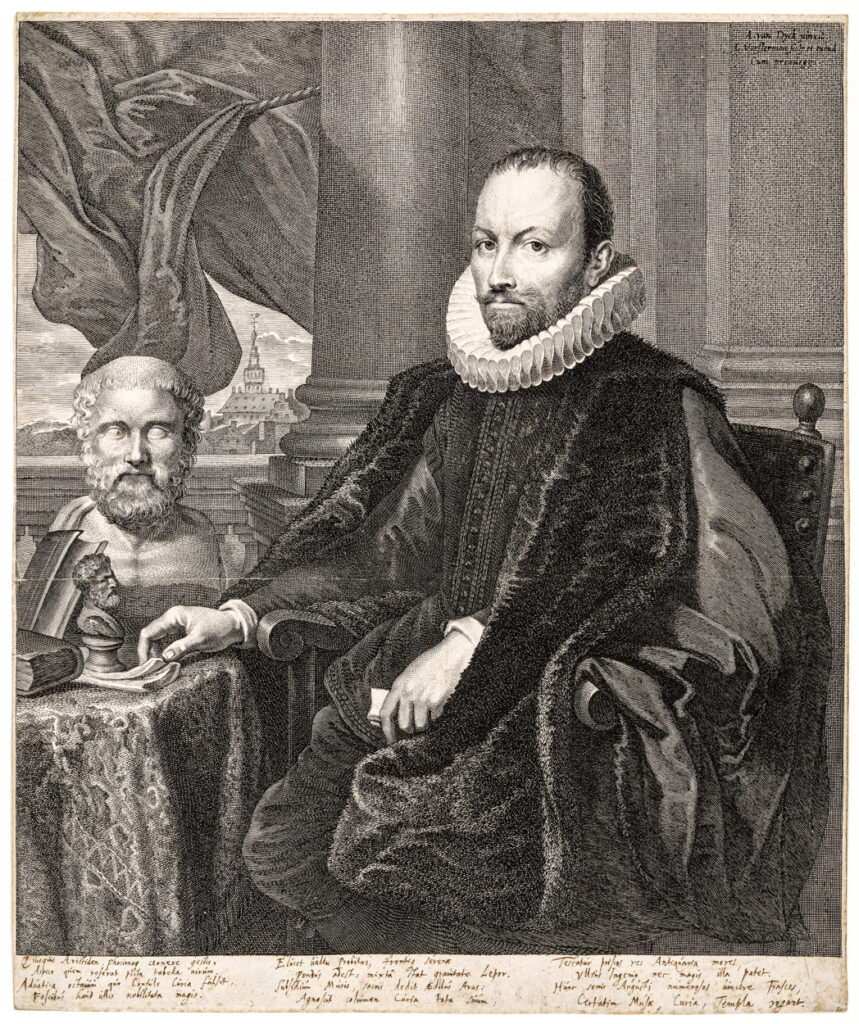
June 18, 2025
SACRAMENTO, Calif. —I want to share with you about a current exhibition at one of my favorite museums, which I urge you to go see if you are in the Sacramento (Calif/USA) area.
The Crocker Art Museum is pleased to announce Arts, Letters, and Power: Van Dyck (1599-1641) and the Portrait Print currently on view at the Crocker Museum from June 22 through October 12, 2025. Arts, Letters, and Power features a selection of etched and engraved portraits from a recent gift by Margaret and Timothy Brown of 188 works from Van Dyck’s Iconography. The prints emphasize the variety of individuals in the series, the complex relationships between the many artists depicted, and Van Dyck’s incredible skill at portraying not just the likenesses of his sitters, but their distinctive qualities and attributes.

Arts, Letters, and Power: Van Dyck and the Portrait Print
Exhibition pulled from the Crocker’s renowned collection of works on paper
Below. Paulus Pontius (Flemish, 1603–1658), after Anthony van Dyck (Flemish, 1599–1641), published by Gillis Hendricx (Flemish, active 1640–1677), Peter Paul Rubens, n.d. Engraving on paper, 8 1/4 x 6 1/8 in. (image). Crocker Art Museum, gift of Margaret and Timothy Brown, 2021.115.100.

Below: Lucas Vorsterman the Elder (Flemish, 1595–1675), after Anthony van Dyck (Flemish, 1599–1641), published by Gillis Hendricx (Flemish, 1640–1677), Anthony van Dyck, n.d. Engraving on paper, 8 7/8 x 6 in. (image). Crocker Art Museum, gift of Margaret and Timothy Brown, 2021.115.2.

Below: Pieter de Jode, II (Flemish, 1606–circa 1674), after Anthony van Dyck (Flemish, 1599–1641), Béatrice de Cusance, Princess of Cantecroix and Duchess of Lorraine, Wife of Charles IV, n.d. Engraving on paper, 9 1/2 x 7 1/2 in. (image). Crocker Art Museum, gift of Margaret and Timothy Brown, 2021.115.161.

The Iconography, which Van Dyck began in the early 1630s, was modeled after the artist’s drawings and paintings. Van Dyck etched 15 of the portraits himself, and the rest were produced by prominent printmakers in his circle, both during and after the artist’s lifetime. Many of the images were issued in multiple states, a reprinting with additional changes.
“Arts, Letters, and Power celebrates Van Dyck’s remarkable skill and savvy,” notes Sarah E. Farkas, Associate Curator of Art at the Crocker Art Museum. “Working around the same time as artistic giants such as Peter Paul Rubens and Rembrandt, Van Dyck understood the commercial potential of prints, which were easily reproduced, transportable, and cheap. Moreover, he knew how to use dynamic and innovative poses to give us a sense of each sitter’s unique character.”
Capturing the likeness of nobility, military leaders, thinkers, and artists of the era, Van Dyck’s familiarity with the era’s power players was not unlike artists today, many of whom also rub shoulders with celebrities and politicians or are splashed across our news feeds. In the seventeenth century, however, the status of the artist was still an unresolved question. Artists had long been associated with artisans and craftspeople in the European social order as producers of consumable goods, no matter how fine and costly those goods were. Increasingly, however, artists sought entry into the realm of the intellectual, likening themselves to poets, scholars, and philosophers. The portrait—specifically, the artist’s self-portrait—was an essential component in early modern debates regarding one’s status.

Although Anthony van Dyck was far from the first European artist to portray himself in a self-portrait, he expanded upon the tradition by depicting himself and many of his peers in the highly reproducible medium of print. In assembling a series of portraits of the artists of his generation alongside those of the dignitaries and the scholars of the day, Van Dyck made a clear argument for the intellectual and cultural importance of his profession, an argument that would influence subsequent artists from Rembrandt to Edgar Degas.

Like Rubens, Van Dyck spent significant time in Italy and France, painting many prominent members of the nobility, where he also encountered the work of Veronese, Titian, and other illustrious Italian artists of the late sixteenth century. These early influences shaped Van Dyck into a masterful colorist, a skill he used to emphasize the elaborate costumes of his elite clientele. At the same time, he learned a keen sense of composition and positioning that flattered his sitters and imbued his portraits with a sense of lifelike grace. Van Dyck consistently injected his figures with lively individualism through detailed attention to naturalism and dynamic positioning.

Anthony van Dyck never indicated how many subjects he intended for the series or in what order they should be presented. This exhibition, not unlike the collectors of Van Dyck’s own era, participates in the centuries-old act of assembling portrait prints from the Iconography, furthering the fame of the many hands involved in their creation.
ABOUT THE CROCKER
The Crocker brings people together and connects them in unexpected ways with art, ideas, each other and the world around them. Founded as a public/private partnership in 1885, the Crocker features the world’s foremost display of California art and is renowned for its holdings of master drawings and international ceramics, as well as European, Asian, African, and Oceanic art. The Crocker serves as the primary regional resource for the study and appreciation of fine art and offers a diverse spectrum of exhibitions, events, and programs to deepen visitors’ understanding of art, including films, concerts, studio classes, lectures, and an array of activities for families and children. More information about exhibits and programs can be found at crockerart.org.
WHERE: Crocker Art Museum. Exhibitions, classes, programs, and more: crockerart.org / @crockerart
Located at 216 O Street, Sacramento, CA 95814
Paid Parking available on adjacent streets and lots.
Connect with Greg Autry
Instagram gregautryphoto.
Photos and Press Release Courtesy of the Crocker Art Museum



Be the first to comment